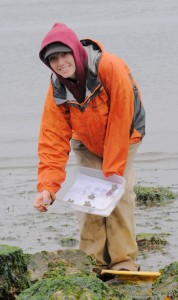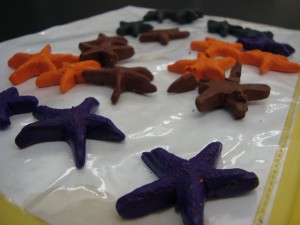Greetings! My name is Mary Krauszer. I am a recipient of a 2010 Summer Research Grant in biology, working under the mentorship of Professor Joel Elliott and in collaboration with student Stephen Reller. The three of us will be spending this summer exploring the mystery of the ochre sea star, Pisaster ochraceus (hereafter referred to as Pisaster), abundant on the coast of Washington state. Specifically, most Pisaster that you find in areas like Puget Sound that are protected from heavy wave action are purple in color. Conversely, on the outer coast of Washington state, which receives plenty of wave action from the open ocean, Pisaster are commonly orange or brown and the purple coloring is less frequent. This color difference between geographic areas has never been explained, and thus our project was born.
From summer research so far I have learned that science is a lot like the third grade. My days are portioned between craft time, fieldtrips, and talking about poop. Craft time: I spend lab time meticulously crafting sea star models, which have already undergone four generational upgrades and are about to experience another. Models began as stock art store clay, evolved into Sculpey clay, were refurbished as lard and flour dough stars, and are finally being revamped with a whole new color system. It is simple to simulate the size and shape of Pisaster (I created molds from real, dried specimens) but reproducing color with models is more complex. Due to the complexity of gull eyes (which are even more complex than your own), gulls are able to see in the ultra violet spectrum, a region of light which humans cannot see. Thus, in matching hues and tones of colors for models, it is also important to consider whether the medium from which a model is created reflects light in the UV. Analyzing this component of the model color requires the use of a spectrophotometer and lots of trial and error with food coloring.
Fieldtrips: On days with “good low tides” (as defined by how much of the intertidal zone will be exposed during the low tide), we venture into the field. On various beaches perform predation trials using the models I created in the lab. I place five of each color of model (orange, purple, brown, and gray) next to rocks on the beach, two meters apart and about one meter away from the water. I then retreat about fifteen meters to my spotting scope and watch as gulls mosey through my 100-meter trial area and (hopefully) join us for lunch (aka attack my models).

Mary Krauszer placing "lard-stars" (dough model sea stars) at Point Defiance for gull predation trials.
Talking about poop: Another interesting side project that has formed as a byproduct of investigating gull eating behavior has been the investigation of gull after-eating products. Gulls commonly eat sea stars and other organisms that contain hard parts like skeletons that are not digested and are therefore visible in excrement. Sea star parts are easily identifiable in gull scat, usually appearing as spines or ossicles (small calcareous plates which make up the skeleton). Thus, I have been counting and collecting gull piles containing ossicles for analysis. As to what kind of data exactly is to be gathered from these droppings, I am not yet sure, but I enjoy washing and sorting poop under a microscope as much as the next guy and I am confident the process will prove enriching.
I will be in the lab promptly at 8:30 am tomorrow to begin color analysis of the newest version of the models in preparation for our trip to Friday Harbor Laboratories in the San Juan Islands beginning Monday. We will stay at the lab for access to its many facilities and in order to perform trials and sea star surveys at locations in the San Juans. I will be there June 7-15, and shall dye my hair teal on Wednesday.

